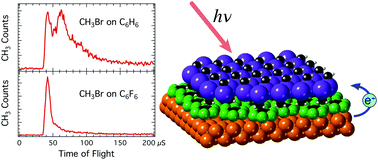Contrasting mechanisms for photodissociation of methyl halides adsorbed on thin films of C6H6 and C6F6
Abstract
The mechanisms for photodissociation of methyl halides (CH3X, X = Cl, Br, I) have been studied for these molecules when adsorbed on thin films of C6H6 or C6F6 on copper single crystals, using time-of-flight spectroscopy with 248 nm and 193 nm light. For CH3Cl and CH3Br monolayers adsorbed on C6H6, two photodissociation pathways can be identified – neutral photodissociation similar to the gas-phase, and a dissociative electron attachment (DEA) pathway due to photoelectrons from the metal. The same methyl halides adsorbed on a C6F6 thin film display only neutral photodissociation, with the DEA pathway entirely absent due to intermolecular quenching via a LUMO-derived electronic band in the C6F6 thin film. For CH3I adsorbed on a C6F6 thin film, illumination with 248 nm light results in CH3 photofragments departing due to neutral photodissociation via the A-band absorption. When CH3I monolayers on C6H6 thin films are illuminated at the same wavelength, additional new photodissociation pathways are observed that are due to absorption in the molecular film with energy transfer leading to dissociation of the CH3I molecules adsorbed on top. The proposed mechanism for this photodissociation is via a charge-transfer complex for the C6H6 layer and adsorbed CH3I.

- This article is part of the themed collection: 2021 PCCP HOT Articles


 Please wait while we load your content...
Please wait while we load your content...